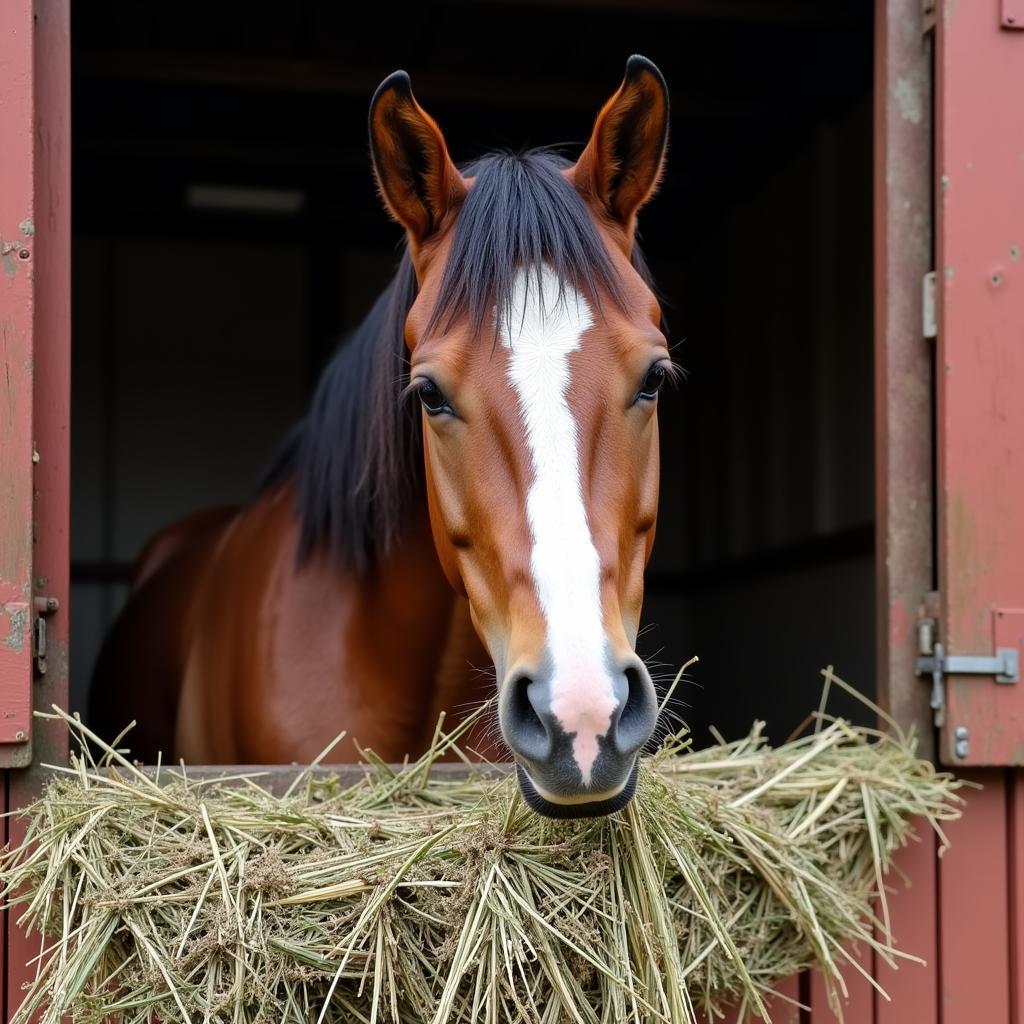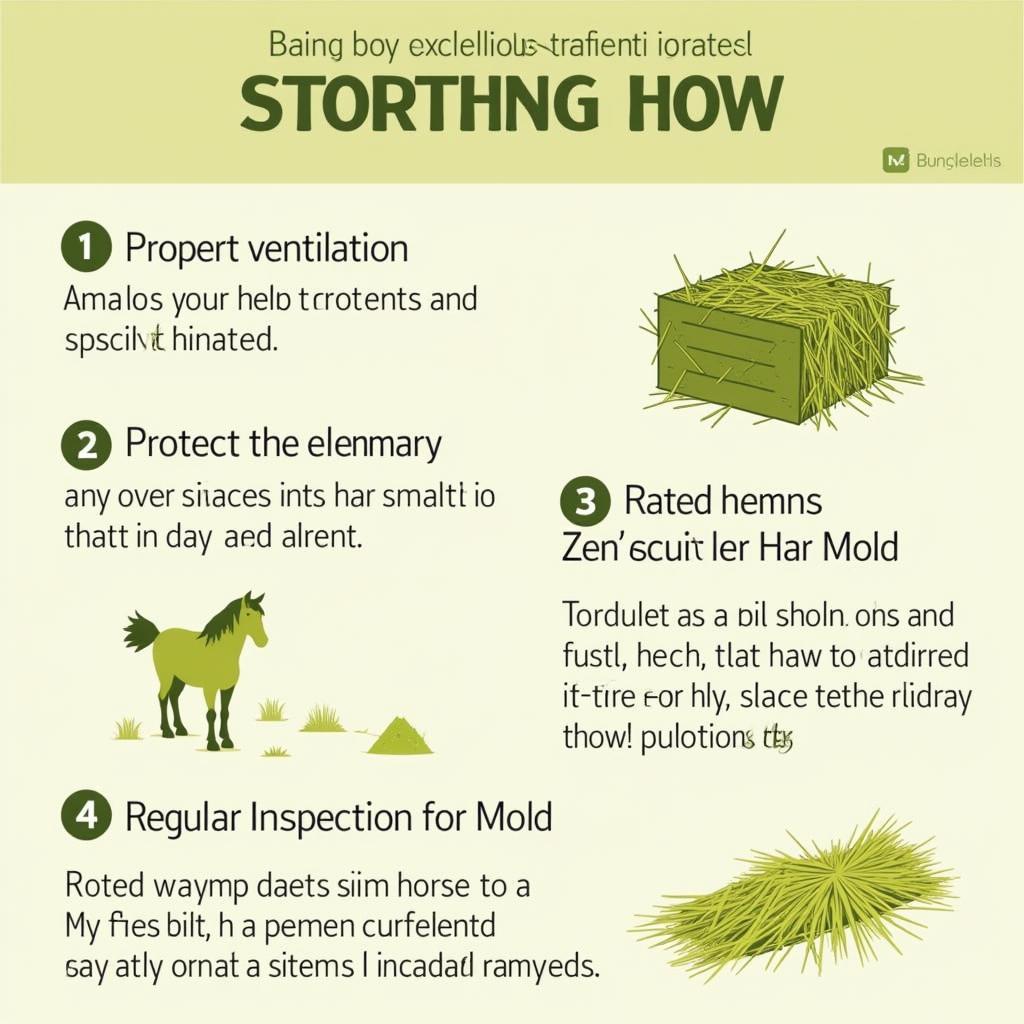Haystack Horse Feed is a common choice for horse owners, but understanding its nuances is crucial for your horse’s health and well-being. This guide delves into the various aspects of haystack horse feed, from its nutritional composition to proper storage and feeding practices. We’ll cover everything you need to know to make informed decisions about incorporating hay into your horse’s diet. If you’re looking for convenient horse boarding in Chattanooga, consider checking out our horse boarding chattanooga tn.
Understanding the Importance of Haystack Horse Feed
Horses are herbivores, and their digestive systems are designed to process large amounts of forage. Hay, specifically haystack horse feed, forms the foundation of a healthy equine diet. Providing your horse with ample, quality hay is paramount for maintaining its digestive health, providing energy, and promoting overall well-being. Choosing the right type of hay and ensuring proper storage is critical.
Different Types of Haystack Horse Feed
Several types of haystack horse feed are available, each with its own unique nutritional profile. Understanding these differences will help you choose the best option for your horse’s specific needs.
Alfalfa Hay
Alfalfa hay is known for its high protein and calcium content, making it an excellent choice for growing horses, lactating mares, and performance horses with high energy requirements.
Timothy Hay
Timothy hay is a popular choice for many horse owners due to its lower protein and calcium content compared to alfalfa. It is a good option for mature, non-working horses, or those prone to certain metabolic conditions.
Orchard Grass Hay
Orchard grass hay is a palatable option often preferred by picky eaters. It offers a balanced nutritional profile and is suitable for a wide range of horses.
Other Hay Types
Other hay types, such as Bermuda grass, fescue, and oat hay, are also available and can be incorporated into a horse’s diet based on individual needs and availability. If you need a horse stall for rent, check our resources on [horse stall for rent near me](https://justushorses.com/horse-stall-for rent-near-me/).
Proper Storage of Haystack Horse Feed
Proper storage is vital for maintaining the quality and nutritional value of haystack horse feed. Hay should be stored in a dry, well-ventilated area, protected from rain and moisture.
Protecting from Moisture
Moisture can lead to mold growth, which can be harmful to horses. Ensuring proper ventilation and covering haystacks during inclement weather are crucial steps in preventing spoilage.
Preventing Mold Growth
Regularly inspecting hay for signs of mold and discarding any affected bales is essential for maintaining your horse’s health.
Feeding Haystack Horse Feed
The amount of hay a horse needs depends on various factors, such as age, activity level, and metabolic needs.
Determining the Right Amount
Consulting with a veterinarian or equine nutritionist can help you determine the appropriate amount of hay for your individual horse.
Feeding Schedule
Establishing a regular feeding schedule can help regulate your horse’s digestive system and prevent digestive upset. Looking for horse boarding near Madison? Visit our page for horse boarding madison wi.
 Horse Enjoying Haystack Feed
Horse Enjoying Haystack Feed
Why is quality haystack horse feed important?
Quality haystack horse feed ensures optimal nutrition and digestive health.
How do I store haystack horse feed properly?
Store hay in a dry, ventilated area away from moisture. Consider checking our options for horse boarding pittsburgh pa.
What are the signs of poor-quality hay?
Mold, dust, and a musty smell indicate poor quality.
“Ensuring the quality of your hay is paramount. It’s the cornerstone of your horse’s diet and directly impacts their health,” says Dr. Emily Carter, DVM, specializing in equine nutrition.
 Best Practices for Haystack Storage
Best Practices for Haystack Storage
Conclusion
Haystack horse feed is a vital component of a horse’s diet. By understanding the different types of hay, proper storage methods, and feeding practices, you can ensure your horse receives the nutrition it needs to thrive. Selecting the right hay and maintaining its quality through proper storage are crucial steps in responsible horse ownership. For horse boarding in Cincinnati, we have resources on horse boarding cincinnati ohio. “Remember, providing quality hay is an investment in your horse’s long-term health and happiness,” adds Dr. Carter.
“A balanced diet, with good quality hay as its foundation, is key to a healthy, happy horse,” shares renowned equine nutritionist, Sarah Miller.
FAQ
-
How much hay should I feed my horse daily? This depends on several factors including size, activity level, and overall health. Consult with your vet.
-
Can I mix different types of hay? Yes, mixing different types of hay can provide a balanced nutritional profile.
-
What is the best way to store hay? Store hay in a dry, well-ventilated area protected from the elements.
-
How can I tell if my hay is moldy? Look for visible mold, a musty smell, and excessive dust.
-
What should I do if my horse won’t eat hay? Consult a veterinarian to rule out any underlying health issues or explore alternative forage options.
-
Is alfalfa hay suitable for all horses? No, alfalfa hay is high in protein and calcium and may not be suitable for all horses, especially those with certain metabolic conditions.
-
How often should I check my hay for quality? Regularly inspect your hay, especially during changes in weather conditions.
For any assistance, please contact us at Phone: 0772127271, Email: [email protected] Or visit our address: QGM2+WX2, Vị Trung, Vị Thuỷ, Hậu Giang, Việt Nam. We have a 24/7 customer service team.